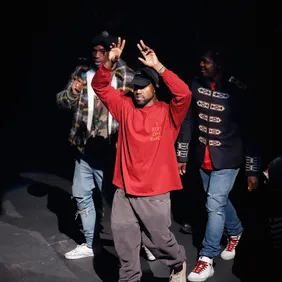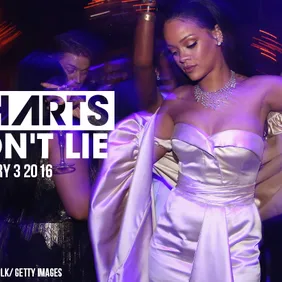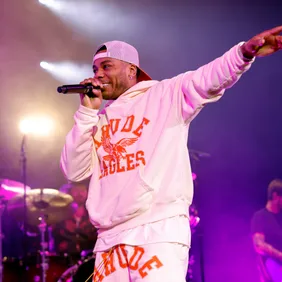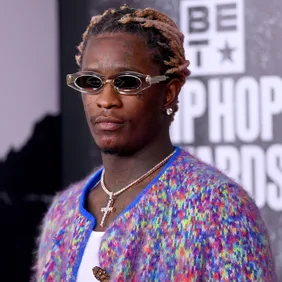The music industry is fraught with uncertainty. Once the be-all and end-all of prosperity, sales are no longer the forthright metric of success. Muddled in the convoluted world of Apple Music, Spotify, Tidal and others, these companies vie for market dominance while today’s biggest stars struggle to make up the deficit in revenue once afforded to their predecessors. Engulfed by jargon and insider terminology, these numbers can seem inaccessible to any layman that doesn’t work in the algorithmic side of the music biz, thus prohibiting fans from gauging the success that their favorite artists are really obtaining.
To cite a recent example, we need only look as far as Young Thug’s latest opus So Much Fun. Unveiled less than a week after its announcement, the numbers reveal the extent of Thugger’s growing hold over his audience. As the curtain closed on the first week, he’d racked up an imposing total of 127,508, besting his nearest competitor in Motown legend Lionel Richie by over 60,000. Raring past the competition in the album-equivalent unit model, what’s notable—and tells us everything about how consumer habits have changed over time—is the disparity between Thug and the former Commodore’s “pure sales.”
Despite resoundingly attracting more album-equivalent units than Richie’s Hello From Las Vegas project, only 5,142 of those came from pure sales. On the other hand, 67, 256 of Lionel’s 67,355 total units came from the more traditional formats. Occupying third place, only 1,5,232 of Quality Control’s Control the Streets Vol 2’s 62,253 were of the pure variety. For many people, this distinction has remained enveloped in mystery and can go a long way in throwing us off the scent. In an effort to declutter this digitized minefield, it’s time to definitively break down what these terms mean for today’s hip-hop artists and how they can bolster their chances of making it to the upper echelons of the charts.
Prince Williams/Getty Images
Introduced in 2016, the revitalized methodology for tallying up their streams was formulated by a collaboration between Billboard and Nielsen. With the latter serving the “most complete and trusted view available of consumers and markets worldwide,” the perennial analytics company and chart statisticians came up with the new plan in direct response to the digitization of the marketplace. The new system equated 150 streams of a singular track to one download. In terms of how this works for album charts, 1500 plays of a particular offering on an album will equate to one entire purchase of a record. To enlist Thugger once more, this means that 1500 plays of “The London” or the Quavo-assisted “Circle Of Bosses” is akin to someone buying a copy of So Much Fun on a digital outlet or by acquiring it on vinyl or CD.
Ever since 2016, Billboard has been striving to refine the process. In May of last year, they officially implemented a two-pronged system that drew a distinction between premium subscribers and those using streaming platforms for free or on a trial basis: “The Billboard 200 will now include two tiers of on-demand audio streams. TIER 1: paid subscription audio streams (equating 1,250 streams to 1 album unit) and TIER 2: ad-supported audio streams (equating 3,750 streams to 1 album unit).” Conceived as a way to be “reflective of a global push to measure streams in a revenue-reflective and access-based manner,” this system is in-line with the altering parameters of the industry, overwhelmingly pointing to streaming as music’s reigning champion.
Taken from an exhaustive report by BuzzAngle, 2018 saw a new record for streams with a grand total of 534.6 billion. To accurately depict the exponential nature of its growth, this is up 42% from 2017’s 376.9 billion. Correspondingly, “total album consumption” also underwent an upswing with the figures rising by 16.2% up to 701 million. By contrast, traditional album sales fell by 18.2% and slumped to a crushing low of 121.2m. Therefore, the concept of an album ever attaining the top spot based off of predominantly “pure sales” is nigh unthinkable for an artist that appeals to a young demographic. In fact, Eminem—who netted the most album sales of the year—was the only solo artist to sell more than 500,000 in pure sales during the entirety of 2018, as Kamikaze occupied the number 3 spot on digital platforms.
Jerritt Clark/Getty Images
The flipside of the coin was epitomized by A Boogie Wit Da Hoodie’s Hoodie SZN. Upon its release in late December, the latest project from the Highbridge MC reached the top of the Billboard chart after three weeks on the peripheries of number one. Boasting 55,000 equivalent units, the doom-mongering that surrounded the release was derived from the pure units—or lack thereof—that he managed to shift along the way. After eventually acquiring the top spot from 21 Savage’s I Am > I Was, his ascension made headlines due to the fact that he only sold a total of 823 physical copies. A testament to the changing of the guard, A Boogie celebrated his victory without any caveats or grievances and matter-of-factly discounted detracting views of his commercial feat. “Streaming took over sales," he declared to TMZ. "Anybody that's in this era now is always going to do more streaming than sales. When I look at it, like, man, fuck sales. We ain't even got no CDs out."
Given this massive, all-encompassing change in direction, it only makes sense that Recording Industry Association Of America chairman Cary Sherman acted in adherence with Billboard and Nielsen in order to incorporate album-equivalent units into gold and platinum certifications. “For nearly six decades, whether it’s vinyl, CDs, downloads or now streams, the gold and platinum program has adapted to recognize the benchmarks of success in an evolving music marketplace," he stated. "We know that music listening – for both for albums and songs – is skyrocketing, yet that trend has not been reflected in our album certifications. Modernizing our Album Award to include music streaming is the next logical step in the continued evolution of the Gold & Platinum Awards, and doing so enables RIAA to fully reward the success of artists’ albums today.”
As a result, A Boogie Wit Da Hoodie’s newsworthy distinction did little to stop Hoodie SZN from garnering platinum status by June of this year.
Astrid Stawiarz/Getty Images
Now that the boundaries for album-equivalent sales and their pure counterparts are firmly established, today’s artists are bound to respond accordingly. Set in a world where persistent plays of one track are counted as undergoing the full listening experience, we have moved into a paradigm where record sales are very much quantitive over qualitative.
While this was technically always the case by design, the new, stream-optimized formulation has essentially resulted in the support of fans and casual listeners becoming indistinguishable from one another on paper. Basically, this means that if you choose to listen to an artist that you’re ambivalent or even scornful towards out of intrigue, your stream and that of 1499 others who do the exact same thing will constitute one album sale. Whereas in days gone by, hearing a song that you didn’t like on the radio and then weighing in on it would have little to no effect on its total sales. For a genre that harbors the most impassioned and opinionated fanbase in the world, album-equivalent units are bound to reign supreme and act as the key to Billboard dominance during this continued commercial boom-period for hip-hop artists.







